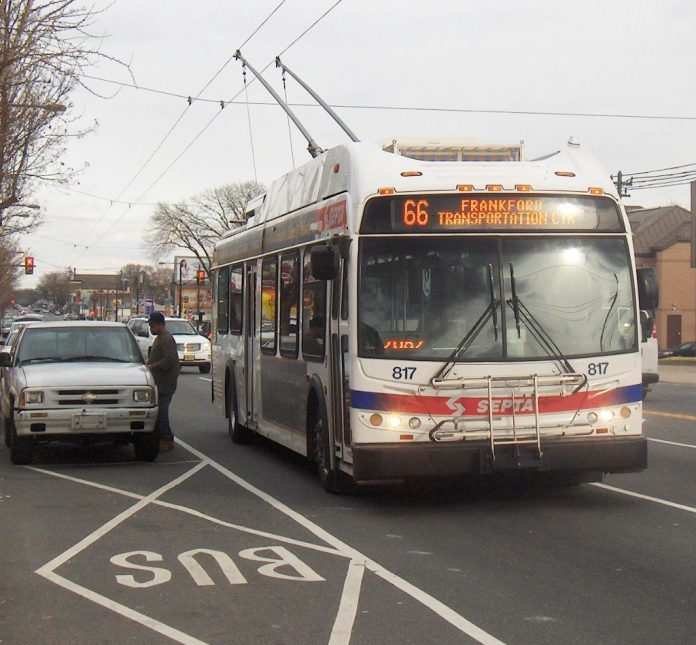A new destination: SEPTA is eliminating 20 regular stops from Route 66 along Frankford Avenue. The changes were to take effect on Sunday, but the trolley will continue to accept passengers temporarily until they become familiar with the new route. SOURCE: WIKIMEDIA
SEPTA announced on Friday that it is eliminating 20 regular stops from the Route 66 trackless trolley service along Frankford Avenue between Bridge Street and the city line. In addition, the public transit agency is modifying an additional seven stops so that riders will board and disembark after the trolley crosses an intersection rather than before the intersection.
The changes were to take effect on Sunday, although SEPTA officials say that the trolley will continue to accept passengers at the former stops for a couple of weeks until commuters become familiar with the new route configuration. Signs have been posted at affected locations advising commuters of the changes, according to the agency.
SEPTA and the Mayor’s Office of Transportation earlier disclosed proposed changes to the route during an Aug. 3 public meeting at the Holmesburg Branch Library. At the time, officials proposed cutting 19 stops. Officials referred to the changes as “consolidations,” in that commuters at each affected location would be directed to the next closest stop.
During the meeting, the transportation officials invited the public to contact SEPTA to comment and potentially affect the proposed changes. The list of consolidations issued on Friday includes one location that was not on the earlier plan. No consolidations were removed from the earlier list. There were about 60 stops on the route prior to the consolidations.
“The changes are part of an effort to improve pedestrian safety and transit efficiency on Frankford Avenue,” SEPTA stated in a news release.
Route 66 covers six miles and connects with the Market-Frankford El at Frankford Transportation Center, allowing riders to travel from Frankford Avenue and Knights Road in the Far Northeast, through Old City, Center City and West Philly, then out to 69th and Market in Upper Darby while making only one transfer.
SEPTA’s general manager, Jeffrey D. Knueppel, was quoted in Friday’s printed statement: “With more than 10,000 riders each weekday, Route 66 is one of SEPTA’s busiest routes. These changes will increase schedule reliability and result in service improvements for all riders along this line.”
The changes coincide with a transit signal priority (TSP) project in the corridor, which will allow SEPTA vehicles to trigger traffic signals on the avenue so that the lights stay green when the trolley is approaching. SEPTA and the city are installing the same technology on five other commercial corridors.
Safety and ridership volume were two factors in the stop consolidations. Transportation officials want commuters to use stops that have traffic signals. And they want to reduce the number of lesser-used stops.
Most of the consolidations are occurring in the northern portion of the route. Among the 20 affected stops, 15 are north of Pennypack Creek.
Also, 11 stops are being eliminated in the southbound direction, while nine are being eliminated northbound. The affected southbound stops, with the nearest stops in parentheses, include: Cartaret (Morrell or Stevenson), Fitler (Eden), Barry (Convent), Aubrey (Pearson), Arendell (Pearson), Academy (Tolbut), Evarts-Far Side (Evarts), Strahle (Kendrick), Oakmont (Shelmire), Aldine (Cottman) and Comly (Cheltenham).
The affected northbound stops, with the nearest stops in parentheses, include: Aldine (Cottman), Marple (Shelmire), Pennypack (Pennypack-Far Side), Evarts-Far Side (Evarts), Academy (Tolbut), Aubrey (Pearson), Barry (Convent), Fitler (Eden) and Cartaret (Morrell or Stevenson).
In seven locations, the trolley stops will be moved from the near side corner of an intersection to the far side corner. The southbound locations are Pearson, Stanwood, Shelmire, Longshore and Tyson. The northbound locations are Tyson and Princeton. ••





